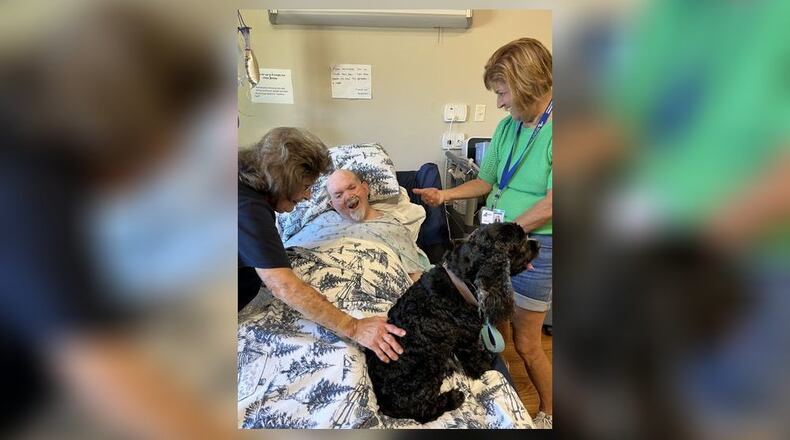“Your dog should have basic obedience training before you start (certification) to make sure your dog is well-socialized,” Cole said. “We basically train you on making sure you and the dog good with other dogs, good with people, and we teach about HIPPA and different things you need to be cautious of before you go into a medical setting.”
Cole, who has been a handler for 20 years, used to take her former dog Sammy to Covenant House. Now she takes her cocker spaniel CoCo to visit with the residents at Austin Trace Health & Rehabilitation.
“A lot of people in nursing homes and senior centers probably don’t have pets, so it’s like an event for them,” Cole said. “I like seeing the joy that it brings to others.”
Cole takes CoCo room to room at Austin Trace, so residents can have their turn petting and playing with the dog. While most people are receptive to CoCo, some residents might not be. While the dog is giving comfort to others, Cole said that the dog also loves the extra attention.
“They can perceive things,” Cole said. “They probably have better perception skills than humans do in some ways.”
Beyond having therapy animals come to the Austin Trace, many people who work there bring their pets to work. This growing trend has helped in employee satisfaction and encourages employees to take more breaks and walks.
Jenny Hatfield, the director of activities at Austin Trace Health & Rehabilitation, brings her rescue dog Cooper into work on certain days during the week. Hatfield has worked in nursing homes for close to 20 years. Other employees bring their pets as well, and the residents start to the learn the pet schedule, which brings them excitement and joy.
“They just love them,” Hatfield said. “It’s reminiscent of being at home. A lot of our residents have had pets, and it brings back a lot of good memories of them being with their dog. And how often we are able to have dogs in the facility creates more of a home environment and less sterile and hospital-like.”
Hatfield said the dogs help the caregivers as well in creating connections with the residents. Everyone looks forward to the day the dog comes to the facility. Also, there are people going through rehabilitation. Hatfield said that the dogs also help residents who have health conditions.
“Being with the dogs, they have time to not think about their conditions and not focus on negative thoughts,” she said. “It’s amazing to see residents with health and physical limitations work up to being able to pet the dog.”
As many people know, being in a nursing home or facility can be lonely. Many times it’s difficult for families to visit on a consistent basis, which can cause residents to feel upset or irritable. If someone is in the facility because of sickness, this also can cause tension.
“Even when I first started bringing my dog, I just loved to see their eyes light up,” Hatfield said. “To see grown men crack a smile. It helps to soften them. With illness, we put up our guard and take care of ourselves. When they see the dogs, they soften and melt a little.”
And it doesn’t stop with dogs. Hatfield said that one of the administrators lives on a farm, so it’s normal to see goats, alpacas and even horses. The goats get little diapers to wear and residents can play with them in the courtyard. Hatfield said they joke about it being like a petting zoo.
“It’s just so fun to watch,” Hatfield said. “The goats run and skip and do their little hops. It’s better than any TV show, and the residents love it. We have so many previous farm owners and this was their life. They just watch and laugh. With the horses, they are just beautiful to look at. They put their heads down to pet, and residents feed them apples and carrots.”
Beyond improving mood and just being so adorable, the benefits seniors can get from pet therapy is immense. Pet therapy can help with mobility issues by keeping them more active. Also, caring for a pet can help increase self-confidence. Hatfield said it’s a win-win for everyone.
“The companionship they provide; there are no words to describe it,” she said. “Residents feel that even in the short time they might be here. And we’re pretty open. You never know who’s bringing them [animals] in.”
MORE DETAILS
For more information on the Miami Valley Pet Therapy Association in Troy, visit www.petsthatcare.com. For more information about Austin Trace Health & Rehabilitation, visit www.austin-trace.net.
About the Author


